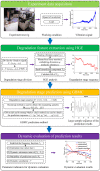A New Approach to the Degradation Stage Prediction of Rolling Bearings Using Hierarchical Grey Entropy and a Grey Bootstrap Markov Chain
- PMID: 38005469
- PMCID: PMC10675129
- DOI: 10.3390/s23229082
A New Approach to the Degradation Stage Prediction of Rolling Bearings Using Hierarchical Grey Entropy and a Grey Bootstrap Markov Chain
Abstract
Degradation stage prediction, which is crucial to monitoring the health condition of rolling bearings, can improve safety and reduce maintenance costs. In this paper, a novel degradation stage prediction method based on hierarchical grey entropy (HGE) and a grey bootstrap Markov chain (GBMC) is presented. Firstly, HGE is proposed as a new entropy that measures complexity, considers the degradation information embedded in both lower- and higher-frequency components and extracts the degradation features of rolling bearings. Then, the HGE values containing degradation information are fed to the prediction model, based on the GBMC, to obtain degradation stage prediction results more accurately. Meanwhile, three parameter indicators, namely the dynamic estimated interval, the reliability of the prediction result and dynamic uncertainty, are employed to evaluate the prediction results from different perspectives. The estimated interval reflects the upper and lower boundaries of the prediction results, the reliability reflects the credibility of the prediction results and the uncertainty reflects the dynamic fluctuation range of the prediction results. Finally, three rolling bearing run-to-failure experiments were conducted consecutively to validate the effectiveness of the proposed method, whose results indicate that HGE is superior to other entropies and the GBMC surpasses other existing rolling bearing degradation prediction methods; the prediction reliabilities are 90.91%, 90% and 83.87%, respectively.
Keywords: degradation stage prediction; grey bootstrap Markov chain; hierarchical grey entropy; rolling bearing.
Conflict of interest statement
The authors declare no conflict of interest.
Figures






































Similar articles
-
Selection of efficient degradation features for rolling element bearing prognosis using Gaussian Process Regression method.ISA Trans. 2021 Jun;112:386-401. doi: 10.1016/j.isatra.2020.12.020. Epub 2020 Dec 11. ISA Trans. 2021. PMID: 33341238
-
Hierarchical Amplitude-Aware Permutation Entropy-Based Fault Feature Extraction Method for Rolling Bearings.Entropy (Basel). 2022 Feb 22;24(3):310. doi: 10.3390/e24030310. Entropy (Basel). 2022. PMID: 35327821 Free PMC article.
-
A Hybrid Generalized Hidden Markov Model-Based Condition Monitoring Approach for Rolling Bearings.Sensors (Basel). 2017 May 18;17(5):1143. doi: 10.3390/s17051143. Sensors (Basel). 2017. PMID: 28524088 Free PMC article.
-
Health Degradation Monitoring and Early Fault Diagnosis of a Rolling Bearing Based on CEEMDAN and Improved MMSE.Materials (Basel). 2018 Jun 14;11(6):1009. doi: 10.3390/ma11061009. Materials (Basel). 2018. PMID: 29904002 Free PMC article.
-
Chaotic prediction of vibration performance degradation trend of rolling element bearing based on Weibull distribution.Sci Prog. 2020 Jan-Mar;103(1):36850419892194. doi: 10.1177/0036850419892194. Epub 2019 Dec 2. Sci Prog. 2020. PMID: 31791201 Free PMC article.
References
-
- Zhao H.M., Liu H.D., Xu J.J., Deng W. Performance prediction using high-order differential mathematical morphology gradient spectrum entropy and extreme learning machine. IEEE Trans. Instrum. Meas. 2019;69:4165–4172. doi: 10.1109/TIM.2019.2948414. - DOI
-
- Yang J., Han S., Zhang S., Liu H., Tang C. Empirical mode decomposition of weak fault characteristic signals of rolling bearing under strong noise background. J. Vib. Eng. 2020;33:582–589.
-
- Wang R., Jin J., Hu X., Chen J. Bearing performance degradation assessment based on topological representation and hidden Markov model. J. Vib. Control. 2021;27:1617–1628. doi: 10.1177/1077546320946633. - DOI
-
- Wang Y.P., Yang C.N., Xu D., Ge J.H., Cui W. Evaluation and prediction method of rolling bearing performance degradation based on attention-LSTM. Shock. Vib. 2021;2012:6615920. doi: 10.1155/2021/6615920. - DOI
-
- Lv M.Y., Zhang C.G., Guo A.B., Liu F. A new performance degradation evaluation method integrating PCA, PSR and KELM. IEEE Access. 2020;9:6188–6200. doi: 10.1109/ACCESS.2020.3048492. - DOI
LinkOut - more resources
Full Text Sources

